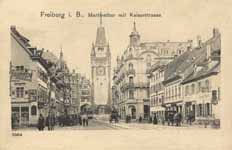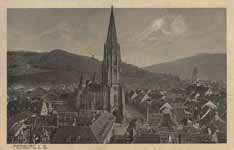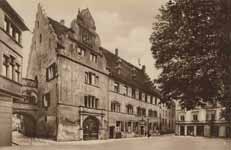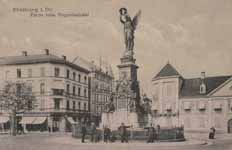.







7,
Freiburg im Breisgau
Freiburg im Breisgau is a city in Baden-Württemberg, Germany. In the extreme south-west of the country, it straddles the Dreisam river, at the foot of the Schlossberg. Historically, the city has acted as the hub of the Breisgau region on the western edge of the Black Forest in the Upper Rhine Plain. One of the famous old German university towns, and archiepiscopal seat, Freiburg was incorporated in the early 12th century and developed into a major commercial, intellectual, and ecclesiastical centre of the upper Rhine region. The city is known for its ancient university and its medieval minster, as well as for its high standard of living and advanced environmental practices. The city is situated in the heart of a major wine-growing region and serves as the primary tourist entry point to the scenic beauty of the Black Forest. According to meteorological statistics, the city is the sunniest and warmest in Germany.[2]
History
Timeline of Freiburg im Breisgau
view • discuss • edit
600 —
–
800 —
–
1000 —
–
1200 —
–
1400 —
–
1600 —
–
1800 —
–
2000 —
–
1120 - Founded by Duke Bertold III of Zähringen
1218 - Inherited by the Counts of Urach
1368 - Purchased its independence
1805 - Became part of Baden
1940-1944 - Heavily damaged during WWII
Freiburg was founded by Konrad and Duke Bertold III of Zähringen in 1120 as a free market town;[3] hence its name, which translates to "free (or independent) town". Frei means "free", and Burg, like the modern English word "borough", was used in those days for an incorporated city or town, usually one with some degree of autonomy.[4] The German word Burg also means "a fortified town", as in Hamburg. Thus, it is likely that the name of this place means a "fortified town of free citizens".
This town was strategically located at a junction of trade routes between the Mediterranean Sea and the North Sea areas, and the Rhine and Danube rivers. In 1200, Freiburg's population numbered around 6,000 people. At about that time, under the rule of Bertold V, the last duke of Zähringen, the city began construction of its Freiburg Münster cathedral on the site of an older parish church.[3] Begun in the Romanesque style, it was continued and completed 1513 for the most part as a Gothic cathedral. In 1218, when Bertold V died, the counts of Urach assumed the title of Freiburg's count.[3][5] The city council did not trust the new nobles and wrote down their established rights in a document. At the end of the 13th century there was a feud between the citizens of Freiburg and their lord, Count Egino II of Freiburg. Egino raised taxes and sought to limit the citizens' freedom, after which the Freiburgers used catapults to destroy the count's castle atop Schloßberg, a hill that overlooks the city center. The furious count called on his brother-in-law the Bishop of Strasbourg, Konradius von Lichtenberg, for help. The bishop answered by marching with his army to Freiburg.
Panoramic view of Freiburg, seen from Schlossberg. Freiburg Münster can be seen in the center.
Old Town Hall
According to an old Freiburg legend, a butcher named Hauri stabbed the Bishop of Strasbourg to death on July 29, 1299. It was a Pyrrhic victory, since henceforth the citizens of Freiburg had to pay an annual expiation of 300 marks in silver to the count of Freiburg until 1368. In 1366 the counts of Freiburg made another failed attempt to occupy the city during a night raid. Eventually the citizens were fed up with their lords, and in 1368 Freiburg purchased its independence from them. The city turned itself over to the protection of the Habsburgs, who allowed the city to retain a large measure of freedom. Most of the nobles of the city died in the battle of Sempach (1386). The patrician family Schnewlin took control of the city until the guildsmen revolted. The guilds became more powerful than the patricians by 1389.
The silver mines in Mount Schauinsland provided an important source of capital for Freiburg. This silver made Freiburg one of the richest cities in Europe, and in 1327 Freiburg minted its own coin, the Rappenpfennig. In 1377 the cities of Freiburg, Basel, Colmar, and Breisach entered into an alliance known as the Genossenschaft des Rappenpfennigs (Rappenpfennig Collective). This alliance facilitated commerce between the cities and lasted until the end of the 16th century. There were 8,000-9,000 people living in Freiburg between the 13th and 14th centuries, and 30 churches and monasteries. At the end of the 14th century the veins of silver were dwindling, and by 1460 only around 6,000 people still lived within Freiburg's city walls. A university city, Freiburg evolved from its focus on mining to become a cultural center for the arts and sciences. It was also a commercial center. The end of the Middle Ages and the dawn of the Renaissance was a time of both advances and tragedy for Freiburg.
Freiburg Münster medieval cathedral
In 1457, Albrecht VI, Regent of Further Austria, established Albert-Ludwigs-Universität, one of Germany's oldest universities. In 1498, Emperor Maximilian I held a Reichstag in Freiburg. In 1520, the city ratified a set of legal reforms, widely considered the most progressive of the time. The aim was to find a balance between city traditions and old Roman Law. The reforms were well received, especially the sections dealing with civil process law, punishment and the city's constitution.
In 1520, Freiburg decided not to take part in the Reformation and became an important center for Catholicism on the Upper Rhine. In 1536, a strong and persistent belief in witchcraft led to the city's first witch-hunt. The need to find a scapegoat for calamities such as the Black Plague, which claimed 2,000 area residents (25% of the city population) in 1564, led to an escalation in witch-hunting that reached its peak in 1599. A plaque on the old city wall marks the spot where burnings were carried out.
The 17th, 18th, and 19th centuries were turbulent times for Freiburg. Through battles in the Thirty Years' War (at the beginning of this war there were 10,000-14,000 citizens in Freiburg; by its end only 2,000) and other conflicts, the city belonged at various times to the Austrians, the French, the Swedish, the Spanish, and various members of the German Confederacy. Between 1648 and 1805, it was the administrative headquarters of Further Austria, the Habsburg territories in the southwest of Germany, when the city was not under French occupation. In 1805, the city, together with the Breisgau and Ortenau areas, became part of Baden.
In 1827, when the Archdiocese of Freiburg was founded, Freiburg became the seat of a Catholic archbishop.
The Martinstor, one of the original city gates in Freiburg
On October 22, 1940, the Nazi Gauleiter of Baden ordered the deportation of all Baden's Jews, and 350 Jewish citizens of Freiburg were deported[6] to the southern French internment camp of Camp Gurs in the Basses-Pyrénées. They remained there under poor conditions until the majority of the survivors were sent to their deaths at Auschwitz on July 18, 1942. The cemetery for German Jews who died at Camp Gurs is maintained by the town of Freiburg and other cities of Baden. A memorial stands outside the modern synagogue in the town center. The pavements of Freiburg carry memorials to individual victims in form of brass plates outside former residences, including that of Edith Stein.
Freiburg was heavily bombed during World War II. First, in May 1940, aircraft of the Luftwaffe mistakenly dropped approximately 60 bombs on Freiburg near the train station, killing fifty-seven people.[7] Later on, a raid by more than 300 bombers of the RAF Bomber Command on 27 November 1944 destroyed a large portion of the city center, with the notable exception of the Münster, which was only lightly damaged. After the war, the city was rebuilt on its medieval plan.
It was occupied by the French Army in 1945, and Freiburg was soon allotted to the French Zone of Occupation. In December 1945 Freiburg became the site of government for the German state Badenia, which was merged into Baden-Württemberg in 1952. The French Army maintained a presence in Freiburg until 1991, when the last French Army division left the city, and left Germany.
On the site of the former French Army base, a new neighborhood for 5,000 people, Vauban, was begun in the late 1990s as a "sustainable model district". Solar power is used to power many of the households in this small community.
Culture
Because of its scenic beauty, relatively warm and sunny climate, and easy access to the Black Forest, Freiburg is a hub for regional tourism. The longest cable car run in Germany, which is 3.6 kilometres (2.2 mi) long, runs from Günterstal up to a nearby mountain called Schauinsland. The city has an unusual system of gutters (called Bächle) that run throughout its centre. These Bächle, once used to provide water to fight fires and feed livestock, are constantly flowing with water diverted from the Dreisam. They were never used for sewage, and such use could lead to harsh penalties, even in the Middle Ages. During the summer, the running water provides natural cooling of the air, and offers a pleasant gurgling sound. It is said that if you fall or step accidentally into a Bächle, you will marry a Freiburger, or 'Bobbele'.
Bächle
The Augustinerplatz is one of the central squares in the old city. Formerly the location of an Augustine monastery which became the Augustiner Museum in 1921, it is now a popular social space for Freiburg's younger residents. It has a number of restaurants and bars, including the local brewery 'Feierling', which has a Biergarten. On warm summer nights, hundreds of students gather here.
The Historical Merchants Hall of 1520-21.
At the centre of the old city is the Münsterplatz or Cathedral Square, Freiburg's largest square. A farmers' market is held here every day except Sundays. This is the site of Freiburg's Münster, a gothic minster cathedral constructed of red sandstone, built between 1200 and 1530 and noted for its towering spire.
The Historisches Kaufhaus, or Historical Merchants Hall, is a Late Gothic building on the south side of Freiburg's Münsterplatz. Built between 1520 and 1530, it was once the center of the financial life of the region. Its façade is decorated with statues and the coat of arms of four Habsburg emperors.
The Altes Rathaus, or old city hall, was completed in 1559 and has a painted façade. The Platz der alten Synagoge "Old Synagogue Square" is one of the more important squares on the outskirts of the historic old city. The square was the location of a synagogue until it was destroyed on Kristallnacht in 1938. Zum Roten Bären, the oldest hotel in Germany, is located along Oberlinden near the Schwabian Gate.
To the east of the city centre, the Schlossberg hill provides extensive views over the city and surrounding region. The castle (Schloss) from which the hill takes its name was demolished in the 1740s, and only ruins remain. However Schlossberg retained its importance to the city, and 150 years ago the city fathers opened up walks and views to make the mountain available to the public. Today, the Schlossbergbahn funicular railway connects the city centre to the hill.[8]
The patron saint of Freiburg is Saint George.
Badische Zeitung is the main local daily paper, covering the Black Forest region.
Geography
Freiburg is bordered by the Black Forest mountains Rosskopf and Bromberg to the east, Schönberg and Tuniberg to the south, with the Kaiserstuhl hill region to the west.
Climate
| Climate data for Freiburg | |||||||||||||
|---|---|---|---|---|---|---|---|---|---|---|---|---|---|
| Month | Jan | Feb | Mar | Apr | May | Jun | Jul | Aug | Sep | Oct | Nov | Dec | Year |
| Average high °C (°F) | 2.8 (37.0) |
6.1 (43.0) |
11.1 (52.0) |
15.6 (60.0) |
20.0 (68.0) |
23.3 (74.0) |
26.1 (79.0) |
25.0 (77.0) |
21.1 (70.0) |
15.0 (59.0) |
8.3 (47.0) |
3.9 (39.0) |
15.0 (59.0) |
| Average low °C (°F) | −2.2 (28.0) |
−1.7 (29.0) |
1.1 (34.0) |
4.4 (40.0) |
8.3 (47.0) |
11.7 (53.0) |
13.3 (56.0) |
13.3 (56.0) |
10.6 (51.0) |
6.1 (43.0) |
2.2 (36.0) |
−1.7 (29.0) |
5.6 (42.0) |
| Precipitation mm (inches) | 41 (1.6) |
41 (1.6) |
53 (2.1) |
66 (2.6) |
81 (3.2) |
99 (3.9) |
89 (3.5) |
86 (3.4) |
79 (3.1) |
74 (2.9) |
58 (2.3) |
51 (2.0) |
818 (32.2) |
| Source: Intellicast[9] | |||||||||||||
Government
Dieter Salomon, mayor of Freiburg
Freiburg is known as an "eco-city". In recent years it has attracted the Bundesamt für Strahlenschutz, solar industries and research; the Greens have a stronghold here (the strongest in any major German city; up to 25% of the overall city vote, in some neighbourhoods reaching 40% or more in the 2002 national elections). The newly built neighbourhoods of Vauban and Rieselfeld were developed and built according to the idea of sustainability. The citizens of Freiburg are known in Germany for their love of cycling and recycling.[10]
The Oberbürgermeister, Dr. Dieter Salomon, (elected in as of 2002), was the first member of Bündnis 90/Die Grünen to hold such an office in a city with more than 100,000 inhabitants. However, his deputy, Otto Neideck, is a member of the conservative party, the CDU.
In June 1992, the Freiburg city council adopted a resolution that it would permit construction only of "low-energy buildings" on municipal land, and all new buildings must comply with certain "low energy" specifications. Low-energy housing uses solar power passively as well as actively. In addition to solar panels and collectors on the roof, providing electricity and hot water, many passive features use the sun’s energy to regulate the temperature of the rooms.[10]
2010 Green Party convention in Freiburg, Dr. Dieter Salomon , Green Party Mayor and Carey Campbell, USA,National Chairman Committee to Draft Michael Bloomberg, & Independent Green Party
Freiburg is host to a number of international organisations, in particular ICLEI - Local Governments for Sustainability, ISES - International Solar Energy Society, and the City Mayors Foundation.[11]
The composition of Freiburg city council is as follows:
Party Seats
Alliance '90/The Greens 12
Christian Democratic Union 10
Social Democratic Party 9
Free Democratic Party 4
Left List / Solidarity City 4
Free Voters 3
Culture List 2
Green Alternative Freiburg 2
Young Freiburg 2
Independent Women 1
TOTAL 48
Education
Albert-Ludwigs University
Freiburg is a center of academia and research with numerous intellectual figures and Nobel laureates having lived, worked, and taught there.
The city houses one of the oldest and most renowned German universities, the Albert Ludwig University of Freiburg, as well as its medical center. Home to some of the greatest minds of the West, including such eminent figures as Johann Eck, Max Weber, Edmund Husserl, Martin Heidegger, and Friedrich Hayek, it is one of Europe's top research and teaching institutions.
Freiburg also plays host to various other educational and research institutes, such as the Freiburg University of Education, the Protestant University for Applied Sciences Freiburg, Freiburg Music Academy, the Catholic University of Applied Sciences Freiburg, the International University of Cooperative Education IUCE, three Max Planck institutes, and five Fraunhofer institutes.
The city is home to the IES Abroad European Union program, which allows students to study the development and activities of the EU.[12]
Transport
Freiburg VAG tram
Freiburg has an extensive pedestrian zone in the city center where no automobiles are allowed. Freiburg also has an excellent public transport system, operated by the city-owned VAG Freiburg. This is anchored by a continually expanding web of tram routes, together with feeder buses.
Freiburg is on the main Frankfurt am Main - Basel railway line, with frequent and fast long-distance passenger services from the Freiburg Hauptbahnhof to major German and other European cities. Other railway lines run east into the Black Forest and west to Breisach. The line to Breisach is the remaining stub of the Freiburg–Colmar international railway, severed in 1945 when the railway bridge over the Rhine at Breisach was destroyed and not replaced.
The city is also served by the A5 Frankfurt am Main - Basel motorway.
Freiburg is served by EuroAirport Basel-Mulhouse-Freiburg, in France, close to the borders of both Germany and Switzerland. Karlsruhe/Baden-Baden airport (Baden Airpark) is approximately 100 km north of Freiburg and is also served by several airlines.
Sports
Freiburg is home to football team SC Freiburg, which plays at the Mage-Solar-Stadion. In the 2010–2011 season, the team will compete in the Fußball-Bundesliga. Freiburger FC is a football club that had early success in the 20th century, but now competes in lower divisions.
Freiburg also has the EHC Freiburg Ice hockey team, which plays at the Franz-Siegel Halle, and the RC Freiburg Rugby union team, which competes in the Regionalliga Baden Wurttemberg.[13]
International relations
See also: List of twin towns and sister cities in Germany
Freiburg has several sister cities throughout the world:
France Besançon, France; since 1959.
Austria Innsbruck, Austria; since 1963.
Italy Padua, Italy; since 1967.
England Guildford, England; since 1979.
United States Madison, Wisconsin; since 1987.
Japan Matsuyama, Japan; since 1988.
Ukraine Lviv, Ukraine; since 1989.
Spain Granada, Spain; since 1991.
Iran Isfahan, Iran; since 2000.
Iranian president Mahmoud Ahmadinejad's controversial comments, which included questioning the dimension of the Holocaust, have sparked discussions concerning Freiburg's partnership with Isfahan. Immediately following the comments, Freiburg's mayor Salomon postponed a trip to Isfahan, but most people involved, especially those in the Alliance '90/The Greens party, were opposed to cancelling the partnership.[14]
Points of interest
Arboretum Freiburg-Günterstal, in the suburb of Günterstal
Freiburg Botanic Garden
University of Freiburg
Haus Zum Walfisch (House of the Whale), which, in Dario Argento's 1977 horror film Suspiria, served as the Dance Academy, the film's central location.
Augustiner Museum
Notable residents
Wolfram Aichele, artist
Hannah Arendt, political theorist
Walter Benjamin, literary critic and philosopher
Alfred Döblin, physician and novelist
Desiderius Erasmus of Rotterdam, Renaissance humanist and theologian
Walter Eucken, economist
Hans F. K. Günther, Nazi eugenicist
Heinrich Haussler, profesional cyclist Cervelo TestTeam
Dany Heatley, player for the Minnesota Wild NHL team
Martin Heidegger, philosopher
Edmund Husserl, philosopher
Walter Kaufmann, philosopher
Boris Kodjoe, US based model and actor, current star of Undercovers
Benjamin Lebert, author and newspaper columnist
Joachim Löw, coach of the German national football team.
Annika Murjahn, actress
Karl Rahner, Catholic theologian
Wolfgang Schäuble, Minister of the Interior, 1989–1991, in Helmut Kohl and, 2005 - current, Angela Merkel governments.
Bernhard Sigmund Schultze, (1827–1919) obstetrician
Jürgen Schrempp, former head of DaimlerChrysler
Berthold Schwarz, fabled alchemist who supposedly introduced gunpowder to Germany
Til Schweiger, actor and director
Hermann Staudinger, Nobel Prize in chemistry "for his discoveries in the field of macromolecular chemistry"
Edith Stein, Saint of the Catholic Church, martyred by the Nazis, member of the Freiburg faculty; her residence is marked by a plaque.
Friedrich von Hayek, economist, philosopher, Nobel Prize laureate in economics
Christoph von Marschall, journalist
Martin Waldseemüller, cartographer
Max Weber, lawyer, political economist, and sociologist
Engelbert Zaschka, one of the first German helicopter pioneers
August Weismann, biologist
Bernhard Witkop, organic chemist
Joana Zimmer, pop singer
Marcel Schirmer, singer and bassist for the metal band Destruction
Gallery
The Freiburger Münster
Inside the belfry of the Freiburger Münster
Landscape seen from the Schlossberg
The University of Freiburg
The Martinstor
The Schwabentor
Historic Merchants Hall (Historisches Kaufhaus) at the Münsterplatz
Observation tower on the Schlossberg
Freiburg's main train station (Hauptbahnhof)
The Konzerthaus (concert hall)
Stadttheater
View of Freiburg
Haus zum Walfisch
Colombi Palace
Fischbrunnen or Fish Fountain.
A shrew's fiddle at the torture museum in Freiburg im Breisgau.
References
^ "Bevölkerung und Erwerbstätigkeit" (in German). Statistisches Landesamt Baden-Württemberg. 20 July 2011.
^ WWW.Wein.de, German Agricultural Society: Baden (read on January 1, 2008).[1]
^ a b c "Stadt Freiburg im Breisgau: History". www.freiburg.de (Stadt Freiburg im Breisgau). Retrieved 2009-04-11., also Arnold, Benjamin German Knighthood1050-1300 (Oxford: Clarendon Press, 1985) p. 123.
^ The American Heritage Dictionary of the English Language: Fourth Edition (2000)
^ German Wikipedia reference to the establishment of the title of Count of Freiburg
^ Spector, Shmuel and Wigoder, Geoffrey, The Encyclopedia of Jewish life Before and During the Holocaust, New York University Press 2001. See Die Synagoge in Freiburg im Breisgau.
^ Robinson, Derek (2005). Invasion 1940. London: Constable & Robinson. pp. 31–32. ISBN 1-84529-151-4.
^ "Erlebniswelt Schlossberg [Experience Schlossberg]" (in German). Stadt Freiburg. Retrieved 2011-02-13.
^ "Freiburg/Breisgau historic weather averages". Intellicast. Retrieved 8 November 2011.
^ a b Is this the greenest city in the world?
^ [2]
^ Study Abroad in European Union – IES Abroad
^ www.freiburg-rugby.de
^ http://www.nouripour.de/presse/96815.html
Further reading
Käflein, Achim (photographs); Huber, Alexander (German text); Freund, BethAnne (English translation) (2008), Freiburg, edition-kaeflein.de, pp. 168, ISBN 978-3940788016}
From Wikipedia, All text is available under the terms of the GNU Free Documentation License

